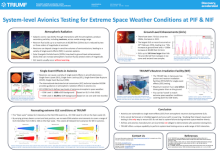System-level Avionics Testing for Extreme Space Weather conditions
Alex
Hands
TRIUMF
Poster
A subset of space weather events known as ground level enhancement (GLE) events can lead to very large enhancements in the atmospheric radiation environment experienced by commercial aircraft. GLEs occur when solar energetic particle (SEP) events have sufficient intensity in the high energy proton spectrum to cause spallation reactions with molecules in the upper atmosphere, leading to high energy neutron cascades all the way to ground level. In extreme cases, neutron fluxes may increase by several orders of magnitude at aircraft altitudes, leading to equivalent increases in single event effect (SEE) rates in aircraft electronics (avionics). Such events cannot be predicted, shielded against or circumvented, therefore the best option for building resilience to their effects is through testing via recreation of the enhanced neutron environment. Although such testing is routine to account for SEE caused by background galactic cosmic rays (GCR), there is currently no regulatory requirement for manufacturers to demonstrate survivability in GLE environments.
Canada’s TRIUMF laboratory has proton and neutron accelerated test facilities for studying SEE and other radiation effects in spacecraft and aircraft electronics. These are being developed for the specific purpose of enabling the study of SEE in avionics during extreme GLEs. Avionics equipment manufacturers will be able to perform system-level tests in a realistic atmospheric neutron spectrum over a wide flux range covering small 1-in-10-year GLEs through to the most extreme 1-in-10,000-year GLEs. This capability will help the aviation industry develop resilience to the most extreme space weather events.
Canada’s TRIUMF laboratory has proton and neutron accelerated test facilities for studying SEE and other radiation effects in spacecraft and aircraft electronics. These are being developed for the specific purpose of enabling the study of SEE in avionics during extreme GLEs. Avionics equipment manufacturers will be able to perform system-level tests in a realistic atmospheric neutron spectrum over a wide flux range covering small 1-in-10-year GLEs through to the most extreme 1-in-10,000-year GLEs. This capability will help the aviation industry develop resilience to the most extreme space weather events.

Poster PDF
Poster category
Aviation Radiation Research and Applications
Poster session day
Poster location
33
Meeting homepage